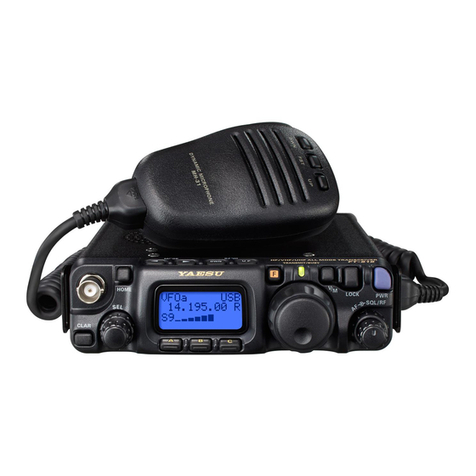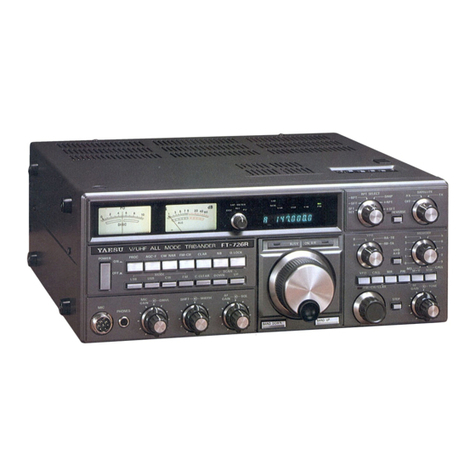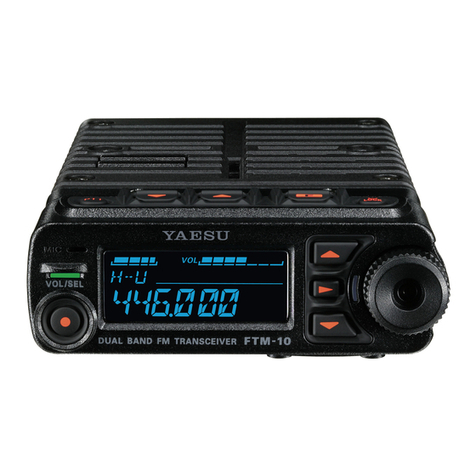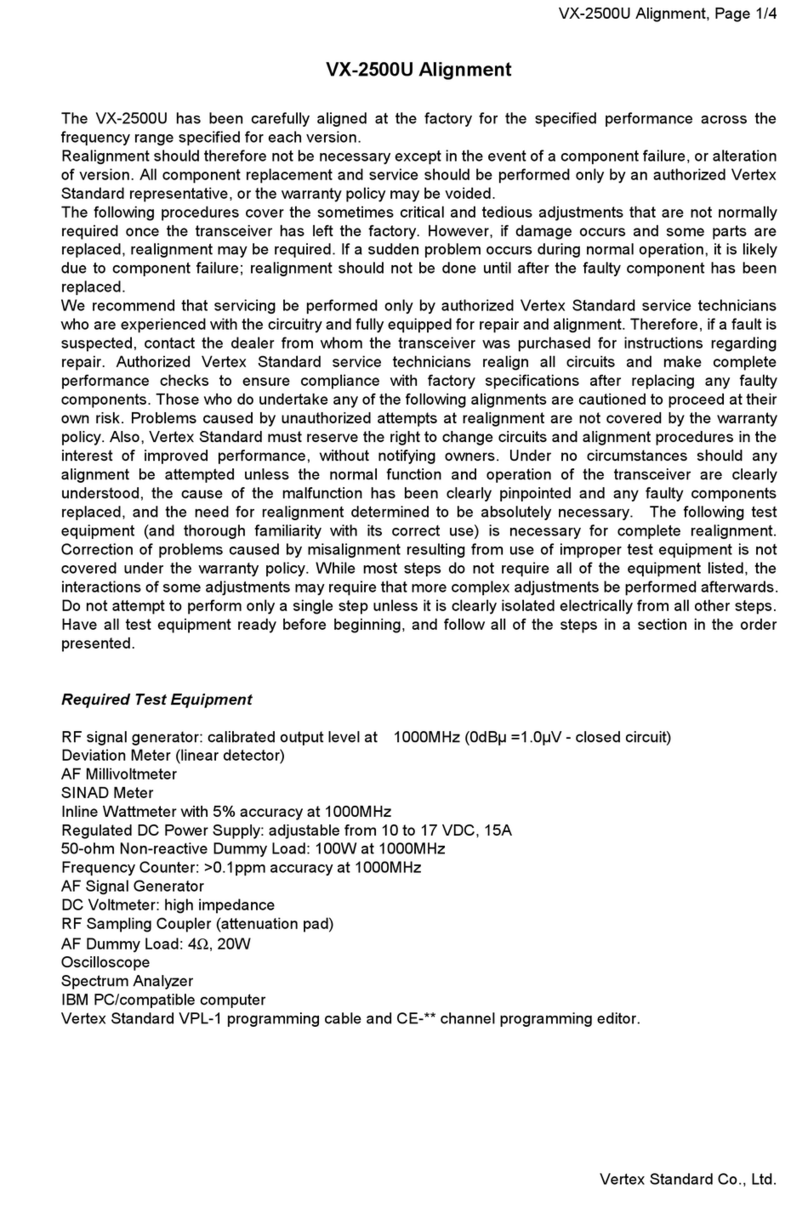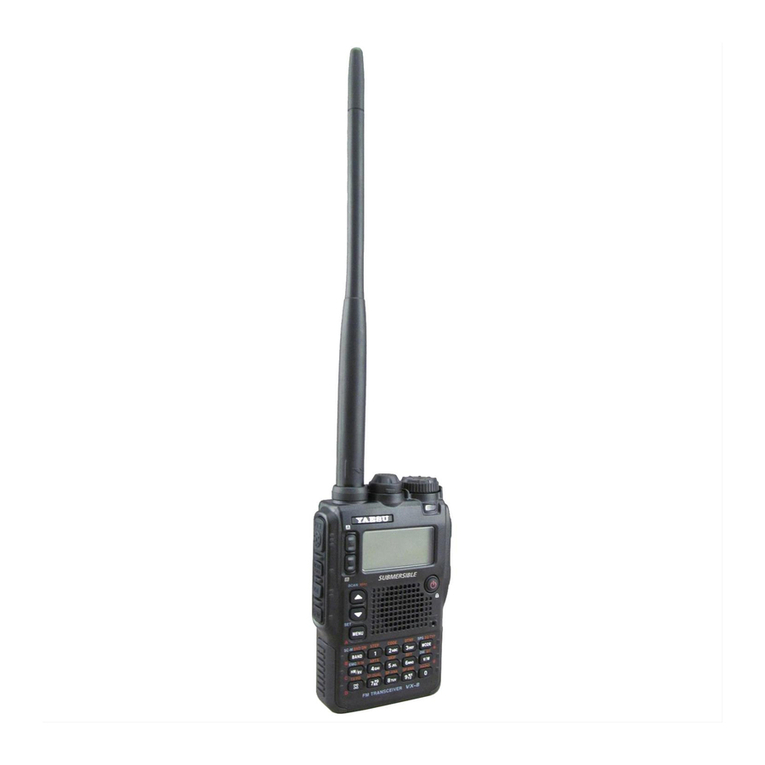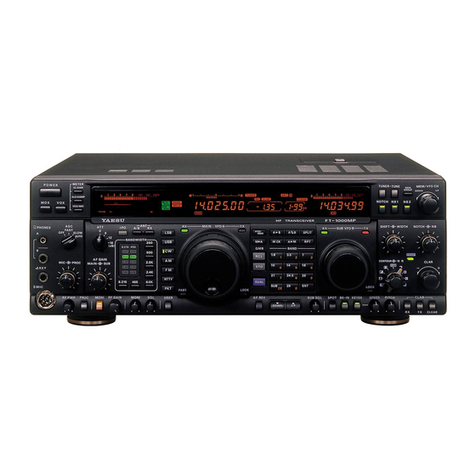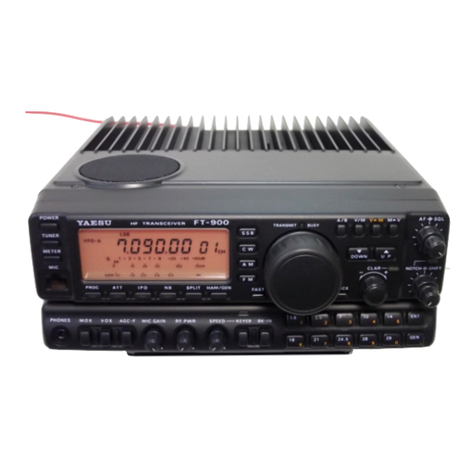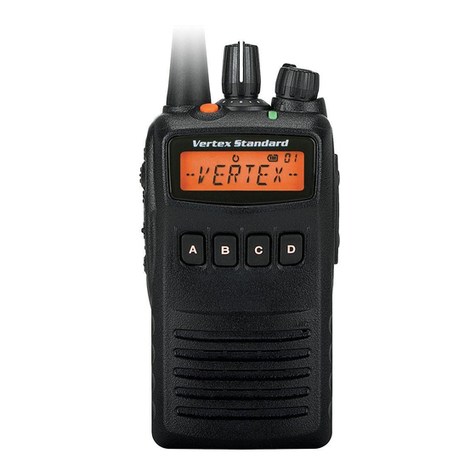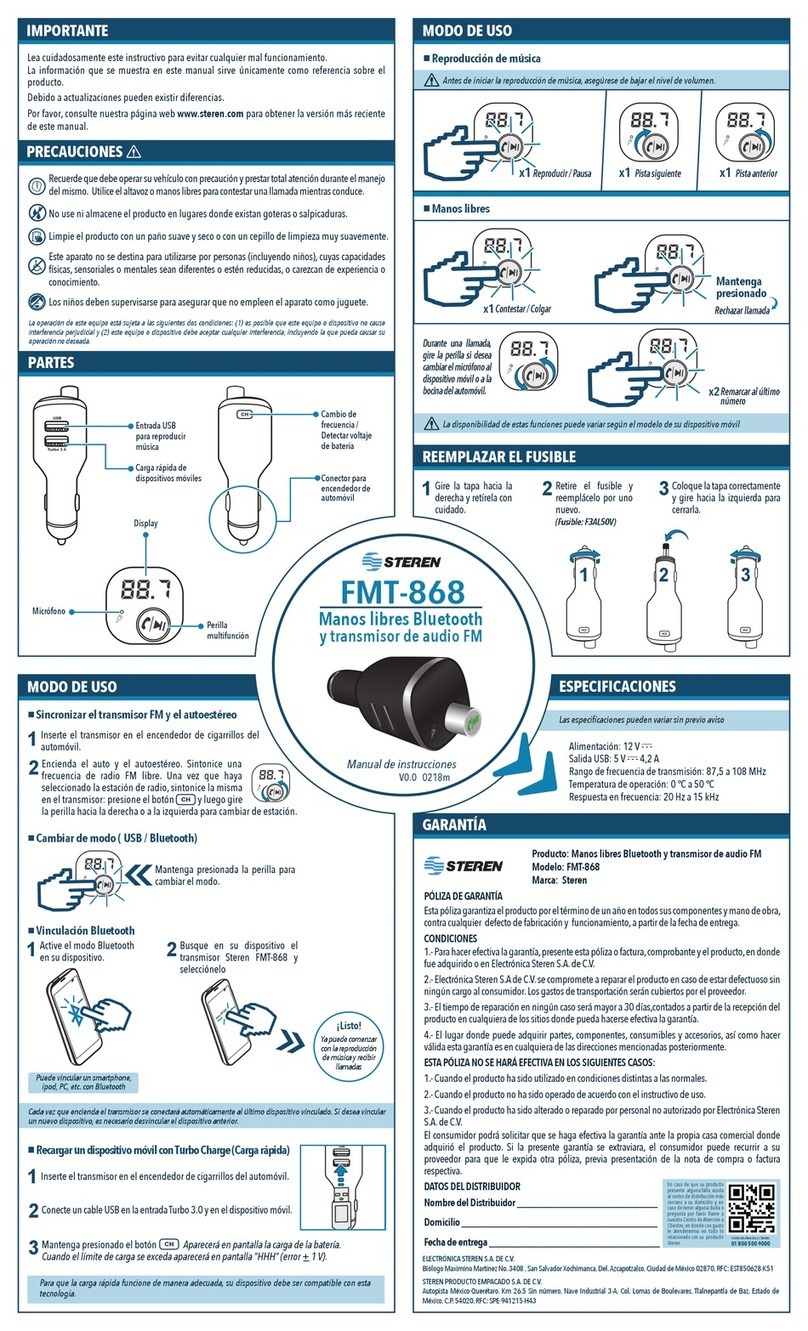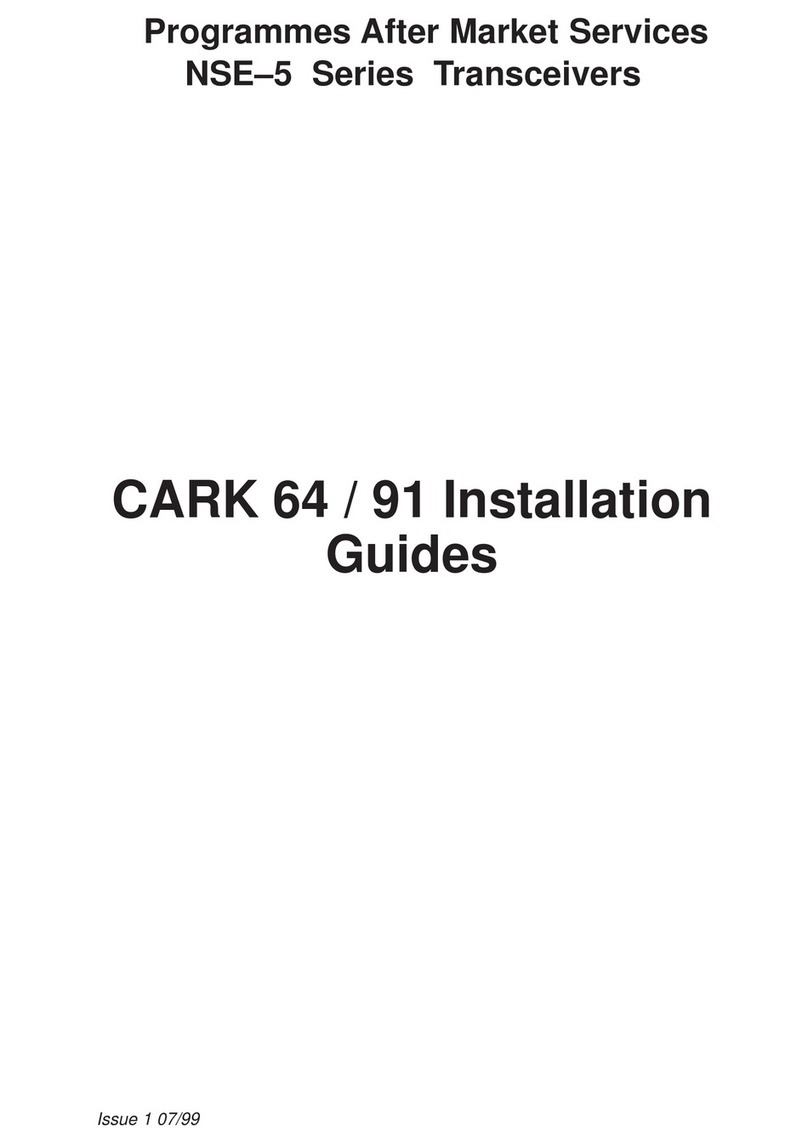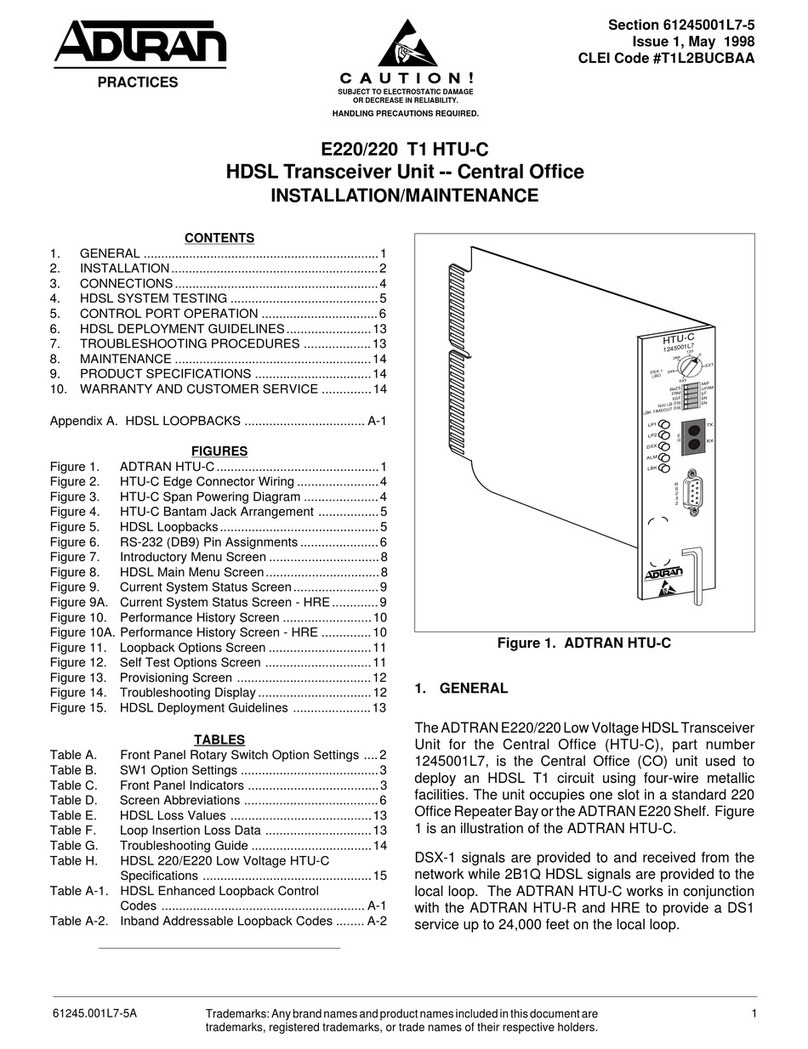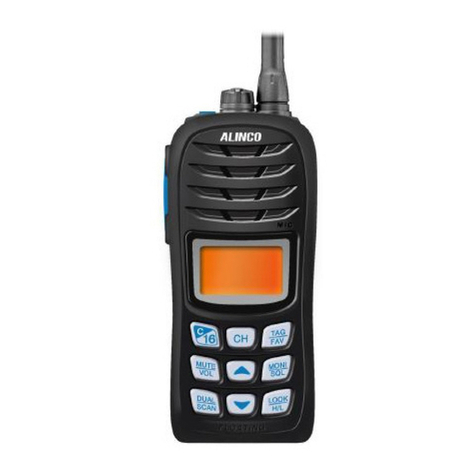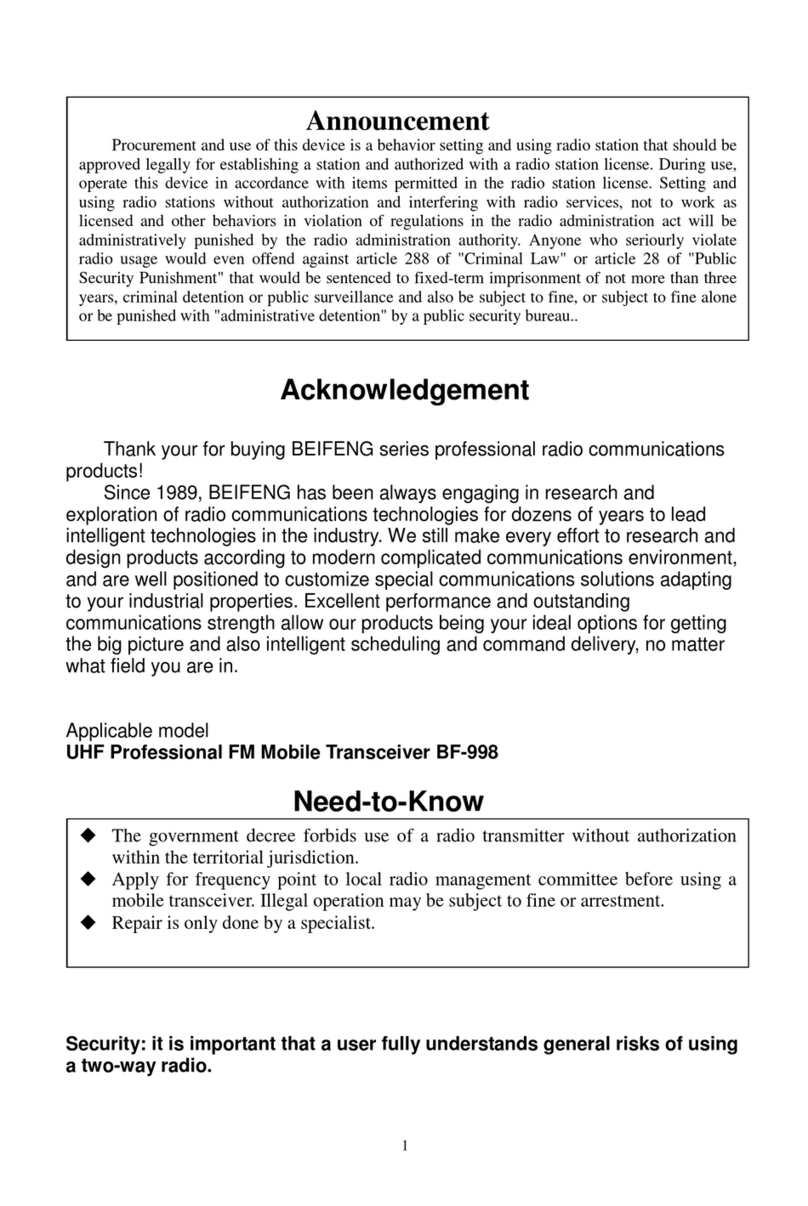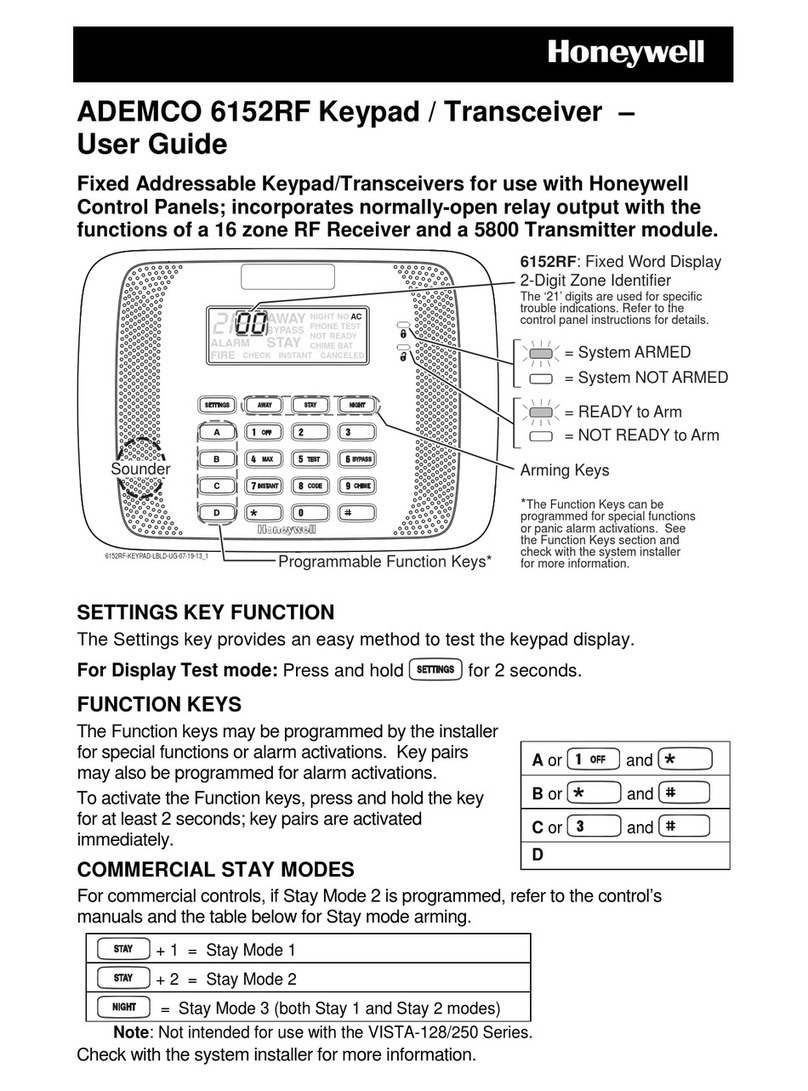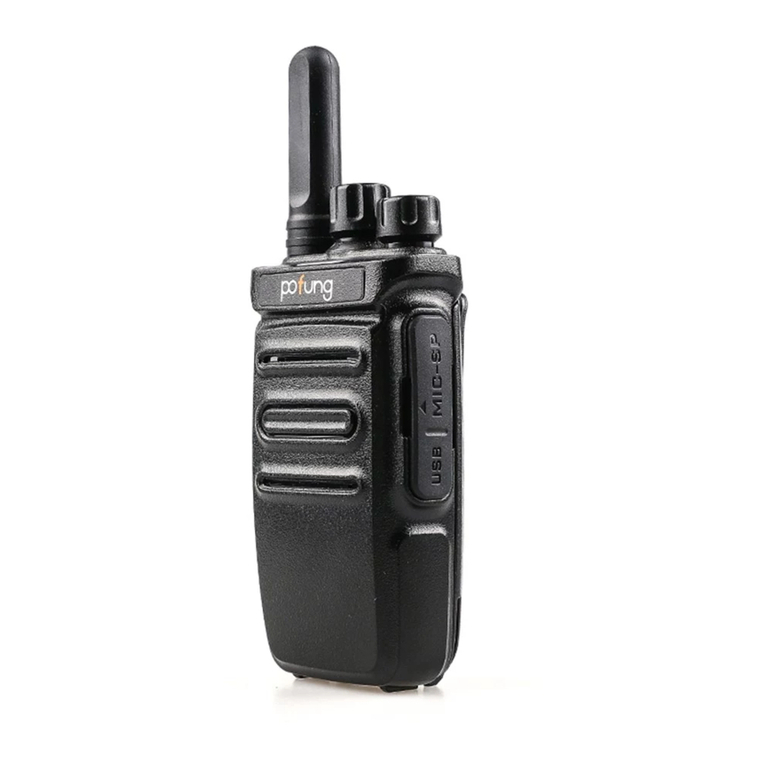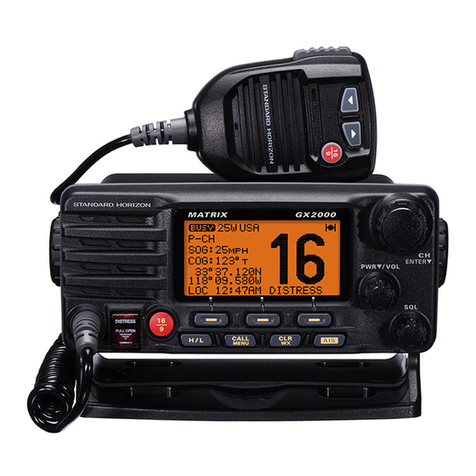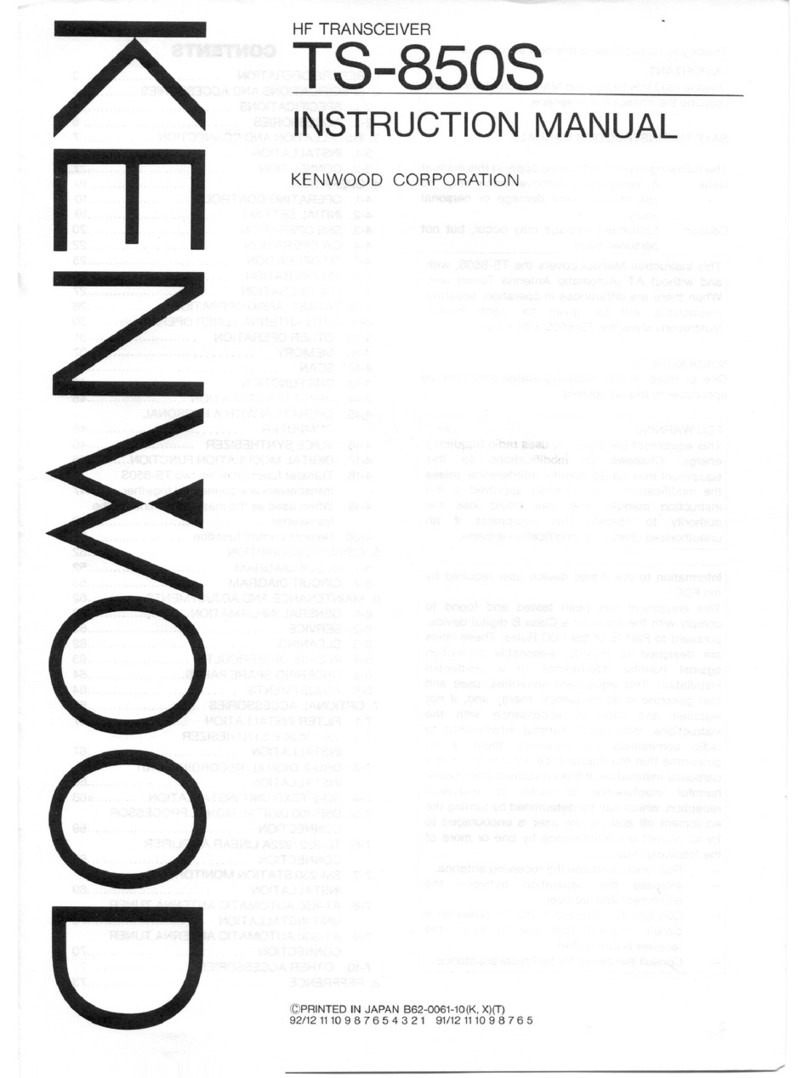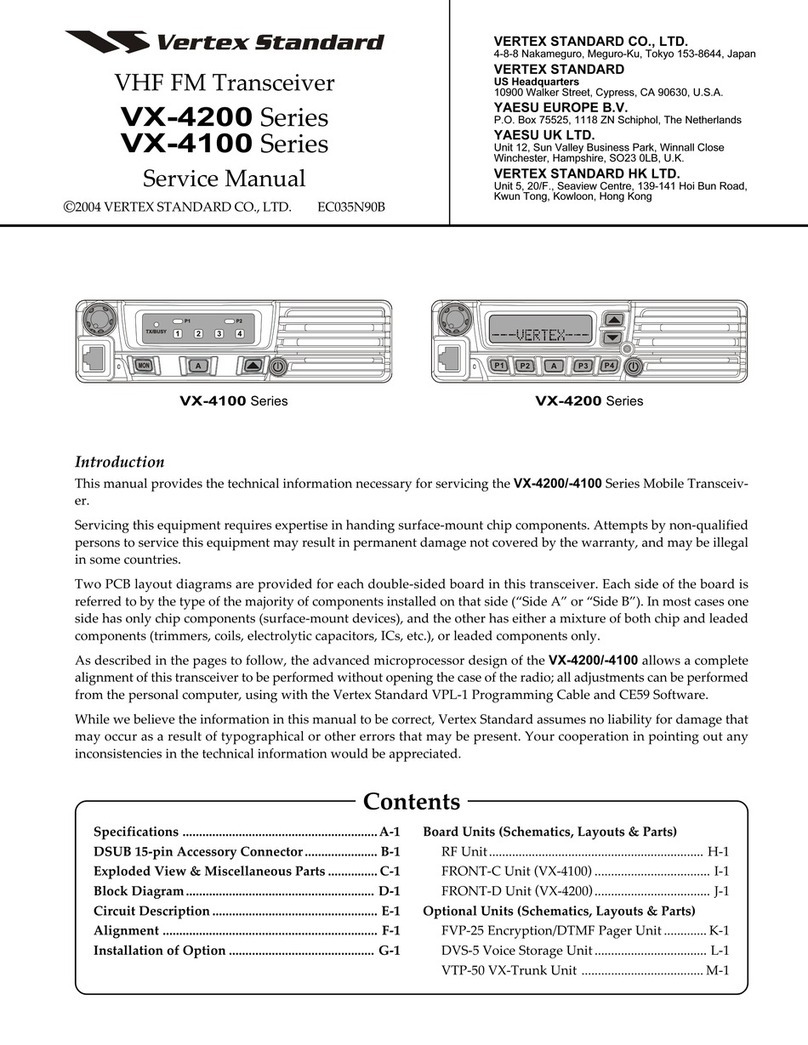Yaesu Mark-V FT-1000MP User manual

HF TRANSCEIVER
Operating Manual
VERTEX STANDARD CO., LTD.
4-8-8 Nakameguro, Meguro-Ku, Tokyo 153-8644, Japan
VERTEXSTANDARD
USHeadquarters
17210 Edwards Rd., Cerritos, CA 90703, U.S.A.
InternationalDivision
8350 N.W. 52nd Terrace, Suite 201, Miami, FL 33166, U.S.A.
YAESU EUROPE B.V.
P.O. Box 75525, 1118 ZN Schiphol, The Netherlands
YAESU UK LTD.
Unit 12, Sun Valley Business Park, Winnall Close
Winchester, Hampshire, SO23 0LB, U.K.
VERTEX STANDARD HK LTD.
Unit 5, 20/F., Seaview Centre, 139-141 Hoi Bun Road,
Kwun Tong, Kowloon, Hong Kong

General Description ..............................................................1
Specifications .......................................................................3
Plug/Connector Pinout Diagrams .........................................4
Accessories & Options .........................................................5
Supplied Accessories ..........................................................5
Available Options ................................................................6
Safety Precautions ................................................................7
Power Connections .............................................................7
Ground Connections............................................................7
Electrical Shock Prevention .................................................8
Antenna Precautions ...........................................................8
RF Field Exposure Advisory & Electromagnetic Compatibility ....8
General Setup .......................................................................9
Preliminary Inspection .........................................................9
Power Connections .............................................................9
Transceiver Location ...........................................................9
Grounding ...........................................................................9
Antenna Considerations..................................................... 10
Adjusting the Front Feet .................................................... 10
Memory Backup ................................................................ 10
Accessory Installation ......................................................... 11
Linear Amplifier Interfacing................................................. 11
Transverter Operation ........................................................ 14
Digital Modem (TNC, WeatherFax, etc.) Interfacing ............. 15
Other Digital/Recording Device Interfacing .......................... 19
CW Key/Paddle and Computer Keying Interface suggestions .. 19
Antenna Connections ........................................................ 20
Personal Computer Interfacing for Contest Software, etc......... 21
Front Panel Controls ........................................................... 22
LCD Bargraph Meter Indications ......................................... 30
Top Panel Access & Controls .............................................. 32
Rear Panel Controls & Connectors ..................................... 34
Operation ............................................................................ 36
Before Starting .................................................................. 36
MARK-V FT-1000MP Menu Programming........................... 36
Receiving .......................................................................... 36
Amateur Band Selection................................................. 36
Mode Selection.............................................................. 37
Tuning the MARK-V FT-1000MP ..................................... 38
Alternate VFO Operation (“Front & Rear” VFO) ............... 40
VFO Selection & Receiver Muting................................... 40
Keypad Frequency Entry ................................................ 40
Signal Tuning Meter Indications ...................................... 41
Expanded Tuning Scale.................................................. 42
AM Synchronous Tuning ................................................ 42
Sub-Display Modes Sellection ........................................ 42
General Coverage Reception ......................................... 43
Dealing with Interference ................................................... 44
VRF (Variable RF Front-end Filter).................................. 44
Front End Selections: Amp Selection, IPO & ATT ............ 44
AGC (Automatic Gain Control) Selection ......................... 45
Noise Blanker ................................................................ 46
IF Filter (Bandwidth) Selection ........................................ 46
WIDTH Control .............................................................. 47
SHIFT Control ............................................................... 48
Notch Filter .................................................................... 48
Clarifier (Rx/Tx Offset Tuning) ........................................ 49
Offset Display Mode ...................................................... 50
Transmitting ...................................................................... 51
Selecting Antennas ........................................................ 51
Automatic Antenna Matching .......................................... 51
SSB Transmission ......................................................... 52
Transmitter Monitor .................................................... 52
Microphone Tone Selection ......................................... 53
RF Speech Processor ................................................. 53
Class-A Operation ...................................................... 53
VOX Operation ........................................................... 54
CW Transmission........................................................... 54
Straight-Key Operation ............................................... 54
Electronic Keyer Operation ......................................... 55
ACS (Auto Character Spacing) .................................... 53
Keyer Settings ........................................................... 56
CW Pitch Setting and Spot Tone ................................. 56
AM Transmission ........................................................... 57
Digital Mode Operation................................................... 57
RTTY Operation ......................................................... 57
Packet Operation ....................................................... 58
1200-Baud FM Packet ................................................ 58
FM Transmission ........................................................... 59
Using SUB VFO B .............................................................60
Dual Reception ..............................................................60
Split Frequency Operation ..............................................62
Sideband Diversity Reception .........................................63
Bandwidth Diversity Reception .......................................63
VFO Tracking.................................................................63
Memory Features ................................................................64
Memory Structure ..............................................................64
Memory Programming .......................................................65
Copying VFO-A Data to Selected Memory .......................65
Recalling & Operating on Memory Channels .......................66
Memory Tuning ..............................................................66
Copying a Selected Memory to VFO-A............................67
Copying between Memories ...........................................67
Grouping Memories ........................................................67
Limiting Memory Group Operation ..............................67
QMB (Quick Memory Bank) Operation ............................68
Scanning Features ..............................................................69
VFO Scanning ...................................................................69
Memory Scanning..............................................................69
Memory Scan Skip.........................................................69
Memory “Masking” .........................................................70
Scan Resume Mode.......................................................70
Scan Skip Disable..........................................................70
Programmed Memory Scanning (PMS Memories P1 ~ P9) ..71
Advanced Features .............................................................72
EDSP ...............................................................................72
EDSP Functions ............................................................73
EDSP RX Audio Enhancement .......................................73
EDSP Noise Reducer .....................................................74
EDSP APF (Audio Peak Filter) ........................................74
IDBT (Interlocked Digital Bandwidth Tracking) System .....74
EDSP Auto Multiple Notch Filter ......................................74
Remote Control Operation .................................................76
Introduction ...................................................................76
I. Contest Keyer Control .................................................76
II. VFO/Memory Control .................................................79
III. MAIN VFO-A Control .................................................79
IV. SUB VFO-B Control ..................................................79
User-Customized Operating Mode ......................................80
Optional DVS-2 Digital Voice Recorder ...............................81
Overview .......................................................................81
Installation .....................................................................81
DVS-2 Controls ..............................................................81
Message Recording (from MAIN or SUB Receiver Audio) ....82
Playback (on the Air of Recorded Receiver Audio) ..............82
Message Recording (from Microphone Audio) .................82
Message Monitor (Playback Without Transmitting) ...........83
Message Transmission (“On the Air” Playback)................83
Phone Patch Operation ......................................................84
Tuning Meter Re-Calibration ...............................................85
CW Tuning ....................................................................85
RTTY Tuning .................................................................85
Packet Tuning................................................................85
CAT System Computer Control ...........................................86
Overview...........................................................................86
CAT Data Protocol .............................................................86
Constructing and Sending CAT Commands ........................87
Downloading MARK-V FT-1000MP Data .............................88
Status Update Organization................................................88
Selecting Updata to Download............................................90
1-Byte Memory Channel Number Data Structure .................90
16-Byte Data Record Structure ...........................................91
Coding Examples ..............................................................93
Menu Selection and Setting ................................................98
Installing Internal Accessories .......................................... 112
TCXO-Unit ...................................................................... 112
Main Receiver 2nd and 3rd IF Filters ................................ 113
Sub Receiver CW Narrow Filter ........................................ 113
Miscellaneous ................................................................... 114
Lithium Battery Replacement ........................................... 114
Internal 13.8V Fuse Replacement .................................... 114
Power-on Setting ............................................................. 115
Tabel of Contents

page 1MARK-V FT-1000MP Operating Manual
Congratulations on the purchase of your Yaesu
amateur transceiver! Whether this is your first rig, or if
Yaesu equipment is already the backbone of your sta-
tion,restassuredthatyourtransceiverwillprovidemany
hours of operating pleasure for years to come.
The MARK-VFT-1000MP isanelite-class HFtrans-
ceiverprovidingexceptionalperformancebothontrans-
mit and receive. TheMARK-V FT-1000MP is designed
for the most competitive operating situations, whether
you primarily operate in contest, DX, or digital-mode
environments.
Built on the foundation of the popular FT-1000MP
transceiver, the MARK-V FT-1000MP provides up to
200 Watts of power output on SSB, CW, and FM (50
Watts AM carrier). Additionally, a Yaesu-exclusive
“Class-A” SSB operating mode provides ultra-linear
signal output, at a power output level of up to 75 Watts.
Also new on the MARK-V FT-1000MP is the IDBT
(Interlocked Digital BandwidthTracking)System,which
automatically aligns the bandwidth of the Enhanced
Digital Signal Processing (EDSP) receiver passband
to match the IF filter passband. This improves operat-
ing efficiency by removing the extra step of making
separate analog and DSP filter adjustments. This fea-
ture can be enabled or disabled with the press of a
button, for maximum flexibility.
And for exceptional protection from strong nearby
incoming signals, the new, Yaesu-exclusiveVRF (Vari-
able RF Front-End Filter)servesasahigh-performance
Preselector-ideal for multi-operator contest environ-
ments. This filter is manually tuned, allowing the op-
erator to optimize sensitivity or signal rejection with the
twist of a knob.
GENERAL DESCRIPTION
Inaddition tothe contributionof theVRFPreselector,
superb receiver performance is a result of direct lin-
eage from the legendary FT-1000D and FT-1000MP.
New technology Direct Digital Synthesizers (two 10-bit
andthree 8-bit)areused in thelocaloscillator (alldriven
by a single TCXO master oscillator), resulting in ex-
tremely fine tuning resolution with thirteen selectable
tuning steps down to 0.625 Hz. You may select either
“Flat” or “Tuned” front end RF amplification (using four
FETs in a double push-pull, constant-gain stage), IPO
(Intercept Point Optimization) utilizing direct feed to the
first mixer, and/or three levels of RF attenuation in 6-
dB steps. The “Tuned” RF Preamplifier provides high
gain and low noise figure on the higher frequency
bands, with lower gain and greater selectivity on the
low bands, where strong-signal performance is criti-
cally important.
To battle QRM, the MARK-V FT-1000MP comes
equipped with a formidable defense. Fine tailoring of
the IF passband is made possible with individually-se-
lected, cascaded 2nd- and 3rd-IF crystal filter banks.
World-renowned Collins®mechanical 500-Hz CW fil-
ters are available as options for the Sub Receiver 2nd
IF, and main receiver 3rd IF strip. An IF notch filter and
concentric IF Shift and Width controls are also pro-
vided. The IF Width circuit allows continuously narrow-
ing receiver passband by selectively moving either the
upper or lower filter skirt just as much as needed to
reduce QRM while still preserving the maximum us-
able bandwidth. This extensive analog IF filtering pro-
tects the EDSP circuits that follow it, ensuring un-
matchedperformance duringcrowded bandconditions.

page 2 MARK-V FT-1000MP Operating Manual
Yaesu’s Enhanced Digital Signal Processing
(EDSP)circuitry,pioneered in theFT-1000MP,provides
a wide array of interference-rejection and signal-
customization features. On receive, three different sig-
nal “Contour” enhancements, in addition to narrow-
bandwidth peaking filters for CW and Data modes, help
dig out weak signals from the noise. Combined with
the EDSP Auto-Notch and Noise Reduction circuits,
the IF analog filters and EDSP response Contours are
without peer in the Amateur Radio industry for signal
enhancement. On transmit, the EDSP Microphone
Equalizer allows matching of the transmitter’s audio
response to your voice’s pattern, thereby maximizing
useful power output in the SSB envelope.
Advanced features include Dual Receive, Direct
Keyboard Frequency Entry and Band Change, RF
Speech Processor, RF Monitor for Voice modes, CW
Pitch control, CW Spot switch, Full CW QSK, adjust-
able IF Noise Blanker, Synchronous Tuning for AM,
and all-mode Squelch. And the Yaesu-exclusive
Shuttle-Jog tuning ring provides a spring-loaded
manual scanning tool, perfect for sweeping across a
band as you take a quick look for activity.
Frequency setup is extraordinarily simple on the
MARK-V FT-1000MP. Besides direct frequency entry
for both the Main and Sub VFOs, separate keys are
provided for band selection, and each band key ac-
cesses two independent VFO frequency/mode/filter
settings per band, so you can establish separate VFO
settings for two different parts of each band. The Sub
VFO has its own banks of VFOs for each band, and
you may copy frequencies from the Main to the Sub
VFO, or swap frequencies between the two, with a
single button push. The two VFOs allow simultaneous
receptionanddisplayof twodifferentfrequencies,even
in different modes and with different IF bandwidths.
Receiver audio can be completely or partially mixed,
or monitored separately in each ear.
In addition, 99 scannable memories are provided,
each of which stores its own mode and IF filter selec-
tion, in addition to frequency, Clarifier offset, and scan-
skip status. What’s more, five quick-recall (“QMB”)
memories can instantly store operational settings at
the push of a button.
The built-in automatic antenna tuner includes 39
memories of its own, automatically storing antenna
matching settings for quick automatic recall later.
A unique feature of theMARK-V FT-1000MP is the
rear panel’s “REMOTE” jack, a multi-featured port
which allows a number of possible control functions.
When connected to the optional FH-1 Keypad (or a
home-made keypad), the REMOTE jack may be used
as a control pad for the contest message keyer, or for
memory/VFO control of the Main or Sub receiver.
Interfacing for digital modes is extremely simple with
the MARK-V FT-1000MP, thanks to dedicated AFSK
and FSK connection jacks on the rear panel. Optimi-
zation of the filter passbands, EDSP settings, carrier
insertion point, and display offset are all possible via
the Menu programming system.
The Yaesu CAT system provides a direct link to
the transceiver CPU for computer control and
customization of tuning, scanning and other operating
functions. The MARK-V FT-1000MP includes a built-
in data level converter for direction connection to a
personal computer serial port. Yaesu products are sup-
ported by most all of the leading contest and DX log-
ging programs, and the programming protocol is in-
cluded in this manual, if you wish to write your own
software!
SpecialoptionsfortheMARK-VFT-1000MP include
the TCXO-6 Temperature Compensated Crystal Os-
cillator module, and a wide selection of IF filters to
complement the four already installed as standard.
External options include the DVS-2 Digital Voice Re-
corder; SP-8 External Loudspeaker with optional LL-7
Phone Patch module; YH-77STA Stereo Headset;FH-
1Remote Control Keypad; and the MD-100A8X Desk-
top Microphone. Rounding out your Yaesu station, the
VL-1000 1 KW Linear Amplifier is specifically designed
to match your MARK-V FT-1000MP,providingthecon-
venience of fully automatic band change along with
1000 Watts of clean power output.
Forsafetransportation oftheMARK-VFT-1000MP,
a supplied separate power, theFP-29, provides the 30
Volt and 13.8 Volt power required for 200-Watt opera-
tion. The reduced weight inside the transceiver case
provides a greater safety margin during the shipment
your MARK-VFT-1000MP viaaparcel service, orwhen
checking it as baggage for a DX-pedition.
Advanced technology is only part of the MARK-V
FT-1000MP story. Yaesu stands behind our products
with a worldwide network of dealers and service cen-
ters. We greatly appreciate your investment in the
MARK-V FT-1000MP, and we look forward to helping
you get the most out of your new transceiver. Please
feel free to contact your nearest dealer, or one of
Yaesu’s national headquarters offices, for technical
advice, interfacing assistance, or accessory recom-
mendation. And watch Yaesu U.S.A.’s Home Page for
late-breaking information about Yaesu products: http:/
/www.yaesu.com.
Please read this manual thoroughly, so as to gain
maximum understanding of the full capability of the
MARK-V FT-1000MP, simply the finest Amateur Ra-
dio transceiver available today!
GENERAL DESCRIPTION

page 3MARK-V FT-1000MP Operating Manual
SPECIFICATIONS
General
RxFrequencyRange:100 kHz - 30 MHz
Tx Frequency Ranges:160 - 10m (Amateur bands only)
FrequencyStability:±0.5 ppm (after 1 min. @ 25 °C)
±0.25 ppm (after 1 min. @ 25 °C, w/TCXO-6)
Operating Temperature Range:–10 °C ~ +50 °C
EmissionModes:LSB, USB, CW, FSK, AFSK, AM, FM
FrequencySteps:0.625/1.25/2.5/5/10 Hz for SSB,CW, RTTY & Packet;
100 Hz for AM and FM
AntennaImpedance:50 Ohms, unbalanced
16.6 - 150 Ohms, unbalanced (Tuner ON, TX only)
Power Consumption:13.8 VDC 30 VDC
Rx (no signal) 2.3A –
Rx (signal) 2.7A –
Tx (200 W) 2.2A 14.5A
Supply Voltage:30 VDC and 13.8 VDC (FP-29)
Dimensions (WHD): 410 x 135 x 347 mm ( 16 x 5.3 x 13.7 inch)
Weight(approx.): 14 kg. (31 lbs)
Transmitter
Power Output:Adjustable up to 200 watts (50 watts AM carrier),
Class A mode (SSB): 75 watts maximum
Duty Cycle:100% @ 100 watts, 50% @ 200 watts (FM & RTTY, 3-minute Tx)
Modulation Types:SSB: J3E Balanced, AM: A3E Low-level (early stage),
FM: F3E Variable reactance, AFSK: J1D, J2D Audio frequency shift keying
Maximum FM Deviation:± 2.5 kHz
FSK Shift Frequencies:170, 425, and 850 Hz
Packet Shift Frequencies:200 and 1000 Hz
Harmonic Radiation:Better than –60 dB (Typical)
SSB Carrier Suppression:At least 40 dB below peak output
Undesired Sideband Suppression:At least 55 dB below peak output
Audio Response(SSB): Not more than -6 dB from 400 to 2600 Hz
3rd-order IMD:–31 dB @ 200 watts PEP, or better
Class A mode: –50 dB @ 75 watts PEP (Typical)
MicrophoneImpedance:500 to 600 Ohms
Receiver
Circuit Type:Quad-conversion superheterodyne (triple conversion for FM)
IntermediateFrequencies:Main Rx; 70.455 MHz/8.215 MHz/455 kHz, Sub Rx; 47.21 MHz/455 kHz
Sensitivity:Modes 0.5 - 1.8 MHz 1.8 - 30 MHz
SSB/CW (2.0 kHz) 2 µV 0.16 µV
AM (6 kHz) 13 µV 2 µV
FM –0.5 µV
(with preamp on, IDBT on, SSB/CW/AM for 10 dB S/N, FM for 12 dB SINAD,
0 dBµ = 1 µV)
Selectivity(–6/–60 dB): Band Width Modes
Minimum –6 dB BW Maximum –60 dB BW
2.4 kHz all except FM 2.2 kHz 4.2 kHz
2.0 kHz all except FM 1.8 kHz 3.6 kHz
500 Hz
CW/RTTY/Packet
500 Hz 1.8 kHz
250 Hz
CW/RTTY/Packet
250 Hz 700 Hz
AM (Wide) 4 kHz 14 kHz
FM 8 kHz 19 kHz
IF Rejection (1.8 ~ 30 MHz): 80 dB or better (Main Rx), 60 dB or better (Sub Rx)
Image Rejection(1.8 ~ 30 MHz): 80 dB or better (Main), 50 dB or better (Sub)
Maximum Audio Output:2.0 W into 4 Ohmswith <10% THD
Audio Output Impedance:4 to 8 Ohms
Specifications are subject to change, in the interest of technical improvement, without notice or obligation.

page 4 MARK-V FT-1000MP Operating Manual
PLUG/CONNECTOR PINOUT DIAGRAMS

page 5MARK-V FT-1000MP Operating Manual
SUPPLIED ACCESSORIES
AC Power Supply FP-29 and its accessories (Separate Carton) .........................................................................1
Hand Microphone MH-31B8 (depending on transceiver version) .........................................................................1
RCA Plug (P0090544) .......................................................................................................................................1
¼-inch 3-contact Plug (P0090008) .....................................................................................................................1
3.5 mm 2-contact Plug (P0090034)....................................................................................................................1
3.5 mm 3-contact Plug (P0091046)....................................................................................................................1
4-pin DIN Plug (P0091004)................................................................................................................................1
5-pin DIN Plug (P0091006)................................................................................................................................1
Operating Manual..............................................................................................................................................1
WarrantyCard...................................................................................................................................................1
ACCESSORIES & OPTIONS

page 6 MARK-V FT-1000MP Operating Manual
ACCESSORIES & OPTIONS
AVAILABLE OPTIONS
TCXO-6HIGH-STABILITYMASTER REFERENCEOSCILLATOR
For special applications and environments where
extra frequency stability is essential, such as for long-
term HF packet monitoring under wide temperature
variations, the TCXO-6 provides ±0.25-ppm stability
the master reference oscillator (after 1 min. @ 25 °C).
MD-100A8X DESK-TOP MICROPHONE
Designedespecially tomatch theelectrical andcos-
metic features of the MARK-V FT-1000MP, the MD-
100A8X has a600 Ohm impedance, and includes an
up/down scanning ring and a large PTT switch with
latch.
SP-8LOUDSPEAKER WITH AUDIO FILTERS &
LL-7PHONE PATCH OPTION
Selectable audio high- and low-pass filters together
with a large loudspeaker complement the superb au-
dio characteristics of the MARK-V FT-1000MP with
your choice of 12 different audio filtering combinations.
Two input terminals are provided for multiple transceiv-
ers, with a front panel switch to select between them.
A (monaural) phone jack is provided on the front panel
to take advantage of the audio filters with headphones.
With the optional LL-7 Phone Patch Unit installed
in the SP-8, the MARK-V FT-1000MP can be patched
to the public telephone network. The LL-7 includes a
hybrid transformer circuit to assure proper impedance
matches, and front panel gain controls and level meter
to set proper audio levels on the telephone line.
YH-77STALIGHTWEIGHT STEREO HEADPHONES
Dual samarium-cobalt transducers with sensitivity
of 103dB/mW (±2dB, @1 kHz, 35 Ohms) provide the
perfectmatch for theMARK-VFT-1000MP.Duringdual
receive with theYH-77STA, one receiver can be moni-
tored in each ear, allowing easy separation of the sig-
nals from the two receivers (or the audio can be mixed,
if desired).
DVS-2DIGITAL VOICE RECORDER
Servingaseithera continuousreceiverrecorderfor
instant pushbutton playback, or microphone audio re-
corder for multiple on-air playback, the DVS-2 applies
the advantages of random-access solid-state digital
memory to serious communications. All data is stored
electronically, with no moving parts except your finger
and the pushbutton. More information is on page 81.
FH-1REMOTECONTROL KEYPAD
The FH-1 is a remote-control accessory designed
to enhance the operating flexibility of your MARK-V
FT-1000MP.The FH-1 permits several remote control
features, which may be selected via Menu program-
ming. More information is on page 76.
IF Crystal Filter Options
Five optional crystal filters may be installed in the
Main Receiver of the MARK-V FT-1000MP,and onein
the Sub Receiver.
Optional Main Receiver Filters
8.2 MHz (2nd IF)
YF-114SN: 2.0-kHz BW (for all modes except FM)
YF-114CN: 250-Hz BW (for all except AM & FM)
455 kHz (3rd IF)
YF-110SN: 2.0-kHz BW (for all modes except FM)
YF-115C CollinsMechanicalFilter:500-Hz BW(forCW
& RTTY)
YF-110CN: 250-Hz BW (for CW only)
Optional Sub Receiver Filter
455 kHz (2nd IF)
YF-115C:CollinsMechanicalFilter500-HzBW(forCW
& RTTY)
Availabilityof accessoriesmayvary:some accessoriesaresuppliedas standardperlocalregulations andrequire-
ments, others may be unavailable in some regions. Check with your Yaesu dealer for additions to the above list.

page 7MARK-V FT-1000MP Operating Manual
SAFETY PRECAUTIONS
Before initiating the installation of your MARK-VFT-
1000MP transceiver, please take the time to review
the following safety guidelines.
POWER CONNECTIONS
We strongly recommend that AC power for your
MARK-V FT-1000MP be provided only from the sup-
plied FP-29 AC Power Supply, so as to ensure that the
voltage and current requirements of the MARK-V FT-
1000MP are fully met.
If you do need to provide DC power to yourMARK-
V FT-1000MP, on an emergency basis, from a power
source other than theFP-29, please be absolutely cer-
tain to observe proper connections in your wiring. Note
that other manufacturers may use the same type of
DCpower connectoras doesYaesu, butthe wiringcon-
figuration of the other manufacturer’s plug will almost
certainly be different from that specified for your trans-
ceiver. The correct wiring diagram is shown below.
GROUND CONNECTIONS
The MARK-V FT-1000MP HF transceiver, like any
other HF communications apparatus, requires an ef-
fective ground system for maximum electrical safety
andbest communicationseffectiveness.A goodground
system can contribute to station efficiency in a number
ofways:
rIt can minimize the possibility of electrical shock to
theoperator.
rIt can minimize RF currents flowing on the shield of
the coaxial cable andthechassisofthe transceiver;
such currents may lead to radiationwhichcancause
interference to home entertainment devicesorlabo-
ratory test equipment.
rItcan minimizethe possibilityof erratictransceiver/
accessory operation caused by RF feedback and/
or improper current flow through logic devices.
An effective earth ground system make take sev-
eral forms; for a more complete discussion, see an
appropriate RF engineering text. The information be-
low is intended only as a guideline.
Typically, the ground connection consists of one or
more copper-clad steel rods, driven into the ground. If
multiple ground rods are used, they should be posi-
tioned in a “V” configuration, and bonded together at
the apex of the “V” which is nearest the station loca-
tion.Useaheavy,braided cable(suchasthediscarded
shield from type RG-213 coaxial cable) and strong
cable clamps to secure the braided cable(s) to the
ground rods. Be sure to weatherproof the connections
to ensure many years of reliable service. Use the same
type of heavy, braided cable for the connections to the
station ground bus (described below).
Inside the station, a common ground bus consist-
ing of a copper pipe of at least 25 mm (1”) diameter
should be used. An alternative station ground bus may
consistofawidecopperplate(single-sidedcircuitboard
material is ideal) secured to the bottom of the operat-
ing desk. Grounding connections from individual de-
vices such as transceivers, power supplies, and data
communications devices (TNCs, etc.) should be made
directly to the ground bus using a heavy, braided cable.
Do not make ground connections from one electri-
cal device to another, and thence to the ground bus.
This so-called “Daisy-Chain” grounding technique may
nullify any attempt at effective radio frequency ground-
ing. See the drawing below for examples of proper
grounding techniques.
Inspect the ground system – inside the station as
well as outside – on a regular basis so as to ensure
maximum performance and safety.
Besides following the above guidelines carefully,
note that household or industrial gas lines mustnever
be used in an attempt to establish an electrical ground.
Cold water pipes may, in some instances, help in the
grounding effort, but gas lines represent a significant
explosion hazard, and must never be used.

page 8 MARK-V FT-1000MP Operating Manual
ELECTRICAL SHOCK PREVENTION
Be certain that all station wiring is properly insu-
lated so as to prevent short-circuits which could dam-
age this transceiver and/or accessories connected to
it. Be sure to protect power cables from damage due
to abrasion by ensuring that they cannot be walked
upon nor crushed under rolling chairs, etc. Never route
power cables near sharp metallic edges which might
cut through protective insulation.
Never spill liquids into this transceiver, and do not
drop sharp metallic objects into the transceiver enclo-
sure. Electrical shock may result when you attempt to
remove the object.
Unsupervised children should be kept away from
any electrical apparatus such as the MARK-V FT-
1000MP transceiver and its accessories.
ANTENNA PRECAUTIONS
Always install antennas such that they can never
come in contact with outdoor power lines in the event
of a catastrophic antenna support or power line sup-
port structure failure. An adequate safety margin is
usually provided by separating power lines from the
antenna and its support structure [1.5 times the height
of the support] plus [the length of any antenna or guy
wires attached to the support] plus [the height of the
power line support pole].
Ground the antenna support structure adequately,
so as to dissipate energy absorbed during a lightning
strike. Install appropriate lightning arrestors in the an-
tenna lead-in and rotator cable (if used) according to
the arrestor’s instructions.
In the event of an approaching electrical storm, dis-
connect all antenna lead-in, rotator control, and power
cables completely from the station, but only if the
storm is not immediately in your area. Do not allow
disconnected cables to touch the case of yourMARK-
V FT-1000MP transceiver or accessories, as lightning
can easily jump from the cable to the circuitry of your
transceiver via the case, causing irreparable damage.
If a lightning storm is in progress in your immediate
area, do notattempt to disconnect the cables, as you
could be killed instantly should lightning strike your
antenna, tower, or a nearby power line.
If a vertical antenna is used, be certain that humans
and/or pets or farm animals are kept away both from
the radiating element (to prevent electrical shock and
RF exposure danger) and the ground system (in the
event of an electrical storm). The buried radials of a
ground-mounted vertical antenna can carry lethal volt-
ages outward from the center of the antenna in the
event of a direct lightning strike.
RF FIELD EXPOSURE ADVISORY&
ELECTROMAGNETIC COMPATIBILITY
This transceiver is capable of power output in ex-
cess of 50 Watts, so customers in the United States
may be required to demonstrate compliance with Fed-
eral Communications Commission (FCC) regulations
concerning maximum permissible exposure to radio
frequency energy. Compliance is based on the actual
power output used, feedline loss, antenna type and
height, and other factors which can only be evaluated
as a system. Information regarding these regulations
may be available from your Dealer, your local radio
club, from the FCC directly (press releases and other
informationcanbefoundon the FCC’ssiteontheWorld
WideWebat<http://www.fcc.gov>),or from theAmeri-
canRadioRelayLeague, Inc. (225MainSt.,Newington
CT06111or<http://www.arrl.org>).
Remembertore-evaluate yourstation’scompliance
with these regulations during portable operations such
asField Dayor special-eventstations.
Regarding electromagnetic compatibility: if this
transceiver is used with, or in the vicinity of, a com-
puter or computer-driven accessories, you may need
to experiment with grounding and/or Radio Frequency
Interference (RFI) suppression devices (such as fer-
rite cores) to minimize interference to your communi-
cations caused by energy from the computer. Com-
puter-generated RFI is usually a result of inadequate
shielding of the computer’s cabinet or I/O and periph-
eral connections. While computer equipment may
“comply” with RF emission standards, this does not
ensure that sensitive amateur radio receivers will not
experience interference from the device!
Be certain to use only shielded cables for TNC-to-
Transceiver connections. You may need to install AC
linefilterson thepowercord(s)of thesuspectedequip-
ment, and decoupling ferrite toroidal chokes may be
requiredon interconnectingpatch/datacables.As alast
resort, you can try installing additional shielding within
the computer’s case, using appropriate conductive
mesh or conductive shielding tape. Especially check
“RF holes” where plastic is used for cabinet front pan-
els.
For further information, consult amateur radio ref-
erenceguidesandpublicationsrelatingtoRFIsuppres-
siontechniques.
SAFETY PRECAUTIONS

page 9MARK-V FT-1000MP Operating Manual
PRELIMINARYINSPECTION
Inspect the transceiver upon opening the packing
carton. Check that all controls and switches work freely,
and inspect the cabinet for any damage. Ensure the
accessory fuses and plugs pictured on page 4 are in-
cluded. If any damage is found, document it completely,
and contact the shipping company (or dealer, if you
purchased it over-the-counter) right away. Save the
packing materials in case you need to return the set
for service. If you have purchased optional internal
accessories separately, install them as described on
page112.
POWER CONNECTIONS
The MARK-V FT-1000MP is designed to be used
in conjunction with the supplied FP-29 Dual-Voltage
Power Supply. Connect the Power Cable from theFP-
29 to the DC IN Jack on the rear panel of the trans-
ceiver.
Note that other manufacturers may use the same
type of DC power connections as does yourMARK-V
FT-1000MP transceiver, but the wiring configuration of
the other manufacturer’s plug almost certainly will be
different from that specified for your transceiver. Seri-
ous damage can be caused if improper DC connec-
tions are made.
GENERAL SETUP
TRANSCEIVER LOCATION
To assure long life of the components, a primary
consideration in setting up the MARK-V FT-1000MP
is providing for adequate ventilation around the cabi-
net. The cooling system of the MARK-V FT-1000MP
must be free to draw cool air in at the lower rear of the
transceiver, and to expel warm air out of the upper rear
panel. Do not place the transceiver on top of another
heat-generating device such as a linear amplifier, and
do not place equipment, books or papers on top of the
transceiver. Also, provide a few centimeters of space
oneithersideofthe transceiver,ifpossible.Avoidheat-
ing vents and window locations that could expose the
transceiver to excessive direct sunlight, especially in
hot climates.
GROUNDING
For protection from electrical shock, and to ensure
proper performance, connect the GND terminal on the
rear panel to a good earth ground, using a heavy
braided cable of the shortest length possible. All other
station equipment should be connected to the same
grounding cable, as close together as practical. If you
use a computer with or near theMARK-V FT-1000MP,
you may need to experiment with ground wiring to sup-
press computer noise in the receiver, and ground loops
during transmission.
Changing the AC Input Voltage Selector Switch on the FP-29 (U.S.A. Users only)
MARK-V
FT-1000MP FP-29
DC Power Cable (Supplied with FP-29)
rBefore changing the Voltage Selector Switch, dis-
connect the FP-29’s AC Power Cable from the AC
line outlet, then wait 10 minutes to allow the power
supply’s electrolytic capacitors to discharge (elec-
trical shock hazard!).
rLocate the Voltage Selector Switch on the bottom
case of the FP-29;removetheprotectiveclearcover
and its nylon rivets from the case.
rMove the Voltage Selector Switch to the appropri-
ate mains voltage for your country (either 230 V or
115 V).
rChange the fuse in the fuse holder on the rear panel
of the FP-29, as indicated below. Do not use slow-
blow type fuses.
AC Mains Voltage AC Fuse Rating
100 ~ 120 V 10A
200 ~ 240 V 6 A
Also, change the voltage marking on the label on
the rear panel of the FP-29 to match the new volt-
age setting.
rReplace the protective clear cover and its nylon riv-
ets. This completes the voltage change procedure.
Warning: Our Warranty does not cover damage
caused by improper supply voltage nor use of an
improper fuse.

page 10 MARK-V FT-1000MP Operating Manual
ANTENNA CONSIDERATIONS
Loss figures are approximate; consult cable manufac-
turers’ catalogs for complete specifications.
Loss figures can increase significantly if high SWR is
present on the transmission line.
ADJUSTING THE FRONT FEET
The two front feet of the MARK-V FT-1000MP can
be set in either of two positions. By turning the knurled
ring around a (retracted) foot clockwise, the middle of
the foot will extend about one centimeter. Turn the ring
as far as it will go (about ¼-turn) to lock the extended
foot in place. To retract an extended foot, turn the
knurled ring counterclockwise ¼-turn while pressing
on the center of the foot.
GENERAL SETUP
MEMORYBACKUP
The memory BACKUP switch on the rear panel is
turned on at the factory, allowing VFO and memory
data to be retained while power is off. Backup current
is miniscule, so it is not necessary to turn the BACKUP
switch off unless the transceiver is to be stored for an
extended period.
Afterfive ormore years ofoperation thetransceiver
may fail to retain memories, at which time the lithium
battery should be replaced. Contact your dealer for
replacement of the battery; for instructions on how to
do so yourself, see page 114.
Loss in dB per 30m (100 feet)
for Selected 50 ΩCoaxial Cables
(Assumes 50 ΩInput/Output Terminations)
(To Retract)(To Extend)
The MARK-V FT-1000MP is designed for use with
any antenna system providing a 50 Ωresistive imped-
ance at the desired operating frequency. While minor
excursions from the 50 Ωspecification are of no con-
sequence, the transceiver’s Automatic Antenna Tuner
may not be able to reduce the impedance mismatch to
an acceptable value if the Standing Wave Ratio (SWR)
present at the Antenna jack is greater than 3:1. Among
the undesirable consequences that high SWR may
produce are:
rThetransceiver’spoweramplifierprotectioncircuitry
will reduce power if the Automatic Antenna Tuner is
unsuccessful in reducing the SWR.
rEven if the Automatic Antenna Tuner successfully
normalizes the impedance presented to the radio,
feedline losses will escalate rapidly with increasing
SWR atthehigheroperatingfrequencies,especially
28 MHz.
rAlthough high SWR itself does not cause feedline
radiation, the sudden onset of high SWR may well
indicate a mechanical failure in a matching device,
leading to an electrical condition which may cause
excessive feedline radiation, which can cause in-
terference to nearby home-entertainment devices.
Every effort should, therefore, be made to ensure
that the impedance of the antenna system utilized with
the MARK-V FT-1000MP be as close as possible to
the specified 50 Ωvalue.
Any antenna to be used with the MARK-V FT-
1000MP must, ultimately, be fed with 50 Ωcoaxial
cable. Therefore, when using a “balanced” antenna
suchasa dipole,rememberthatabalun orothermatch-
ing/balancing device must be used so as to ensure
proper antenna performance.
The same precautions apply to any additional (re-
ceive-only) antennas connected to theRXANT jack; if
your receive-only antennas do not have an impedance
near 50 Ωat the operating frequency, you may need to
install an external antenna tuner to obtain optimum
performance.
Use high-quality 50 Ωcoaxial cable for the lead-in
to your MARK-V FT-1000MP transceiver. All efforts at
providing an efficient antenna system will be wasted if
poor quality, lossy coaxial cable is used. Losses in co-
axial lines increase as the frequency increases, so a
coaxial line with only 0.5 dB of loss at 7 MHz may have
2 dB of loss at 28 MHz. For reference, the chart in the
next column shows approximate loss figures for typi-
cally-available coaxial cables frequently used in ama-
teur radio installations.
Cable Type
RG-58A
RG-58Foam
RG-8X
RG-8A,RG-213
RG-8Foam
Belden®9913
RG-17A
Loss:
2 MHz
0.55
0.54
0.39
0.27
0.22
0.18
0.88
Loss:
15 MHz
1.75
1.50
1.07
0.85
0.65
0.50
0.30
Loss:
28 MHz
2.60
2.00
1.85
1.25
0.88
0.69
0.46

page 11MARK-V FT-1000MP Operating Manual
LINEAR AMPLIFIER INTERFACING
ACCESSORYINSTALLATION
The MARK-V FT-1000MP can be used with the
optional Yaesu FL-7000 or VL-1000 Linear Amplifier,
providing automaticband switchingviadigitalband data
output from the BAND DATA jack on the rear panel of
the transceiver. Most other amplifiers can be adapted
to operate with the MARK-V FT-1000MP;however,the
main points to be concerned with are the switching re-
quirements of the amplifier, and if QSK (full break-in)
operation is desired. The linear amplifier Tx/Rx switch-
ing capability of the MARK-V FT-1000MP is described
in the table below.
OPERATION WITH QSK AMPLIFIERS
Connect the RF output from the transceiver ANT
jack (Aor B) to the RF input jack of the linear. Connect
the ALC output from the linear to theEXT ALC jack on
the rear of the transceiver (see the “About ALC” dis-
cussion below).After makingthe RFand Tx/Rxswitch-
ing connections described below, you may need to
adjust the ALC output level of the linear so that it is not
overdriven by the MARK-V FT-1000MP. Your linear’s
manual should describe how to do this.
If using aVL-1000, connect the BAND DATA Cable
(supplied with the VL-1000)fromthetransceiverBAND
DATA jack to the amplifier BAND-DATA 1 jack;this will
provide automatic band selection for the linear, as well
as QSK Tx/Rx switching control. You may also con-
nect auser-constructed control cable (refer to VL-1000
manual for details) from the transceiverREMOTE jack
to the amplifier BAND-DATA 2 jack to provide auto-
matic amplifier tune-up for the linear using the MARK-
V FT-1000MP. Press the VL-1000’s front panel ATT
switch to activate the 3 dB input RF power attenuator,
to pad the 200 Watt (maximum) input power from the
MARK-VFT-1000MP.
Operation
Parameter
DC Switching
Voltage
DC Swiching
Current
AC Switching
Voltage
AC Swiching
Current
QSK
RelayDisabled
< 40VDC
< 150 mA
–
–
Non-QSK
RelayEnabled
< 60 VDC
< 200 mA
< 100 VAC
< 500 mA

page 12 MARK-V FT-1000MP Operating Manual
If using an FL-7000, connect optional cable E-767
(P/ND4000019) fromthe transceiverBANDDATA jack
to the amplifier ACC-2 jack. This provides automatic
band selection for the linear, as well as QSK Tx/Rx
switching control. Turn on theFL-7000 rear panel ATT
switch to activate the 3 dB input RF power attenuator,
to pad the 200 Watt input power from theMARK-V FT-
1000MP.
If using another manufacturer’s QSK linear, and if
its switching circuitry consumes less than 150 mA of
DC voltage below 40 V, you can connect the Tx/Rx
switching line for the linear to pin 2 (“TX GND”) of the
BANDDATA jack (usepin3forground),and thelinear’s
exciter-enable output to pin 8 (“TX INHIBIT”) of the
BAND DATA jack. This line must be switchedto ground
to enable transmission once the linear is ready for ex-
citation from theMARK-V FT-1000MP. If your QSK lin-
ear sinks more than 100 mA or uses more than 15 V
for T/R relay switching, you will have to provide a suit-
able external interface transistor, controlled by pin 2.
Be certain to make provision for suitable reduction of
the drive power from the MARK-V FT-1000MP, so as
not to damage your amplifier.
LINEAR AMPLIFIER INTERFACING
OPERATION WITH NON-QSK AMPLIFIERS
(FL-2100 SERIES OR OTHERS)
The TX GND jack on the transceiver rear panel is
connected to an internal relay, for non-QSK T/R switch-
ing of linear amplifiers that use AC switching voltage,
orDC voltagegreater than +15 V, negative DC voltage
of any kind (such as the Heath®SB-220/SB-221 mod-
els), or if they are required to sink more than 100 mA
for T/R switching. A schematic diagram of the relay
circuit is provided below. If not using your linear ampli-
fier in a full break-in environment, the use of this relay
for amplifier switching is highly recommended.
This relay comes disabled (rear-panel LIN set to
“OFF”) to avoid the clicking sound when the transceiver
is used alone or with a QSK linear. To enable the relay
for non-QSK linears that exceed the above T/R switch-
ing requirements, you will need to move the LIN switch,
located in the hole near the center of the rear panel, to
its right position (see the drawing). Use a thin, insu-
lated, sharp object to move the switch. Then connect
the center contact of the TX GND jack to the positive
relay-control line to your linear, and the outer contact
to the “common” line or the linear’s chassis ground.
Refer to the diagram at the next page;in this example,
a older non-QSK amplifier (FL-2100B) is shown.
With the relay now enabled, the MARK-V FT-
1000MP can support non-QSK linear T/R switching
voltages up to 100 VAC @ 500 mA, or DC voltage up
to 60 V @ 200 mA, or closed-circuit current up to 1 A
with DC voltage up to 30 V.
ACCESSORYINSTALLATION

page 13MARK-V FT-1000MP Operating Manual
Caution - Please Read!!
The MARK-V FT-1000MP is designed for use with
the FL-7000/VL-1000 when QSK operation with a
linear amplifier is desired. If you are using a differ-
ent amplifier,do not attempt QSK operation with
the linear if its switching circuitry requires that the
MARK-V FT-1000MP’s relay be enabled. Using
pins 2 and 8 of the BAND DATA jack for other
amplifiers will not work unless the control line sig-
nals are carefully matched, and damage may re-
sultotherwise.
During linear operation, be sure to account for the
MARK-V FT-1000MP’s maximum power capabil-
ity of 200 Watts, and take care not to over-drive
your linear amplifier.
Your transceiver’s warranty does not cover dam-
age resulting from improper connections to this
jack, so if you are not sure of the linear amplifier’s
break-in capabilities or switching requirements, the
safest approach is to enable the relay, use theTX
GND jack (after setting the LIN switch to the “ON”
position) and resort to non-QSK operation. This will
help prevent possible damage to the amplifier or
transceiver.
LINEAR AMPLIFIER INTERFACING
ABOUT ALC
The MARK-VFT-1000MP providesan external ALC
jack on the rear panel (RCA-type jack) for input of Au-
tomatic Level Control voltage from a linear amplifier.
ALC voltage is used to provide dynamic control of
the output of the transceiver, so as not to provide more
drive than is needed for full amplifier output. The ALC
control voltage range is 0 to –4 V DC, with the voltage
going more negative as the amplifier’s drive require-
ments are approaching fulfillment.
The MARK-VFT-1000MP’sALCsystemisverytypi-
cal of designs in the amateur radio industry, and con-
sequently is compatible with many manufactured and
home-built amplifiers. However, ALC voltage may be
generated by an amplifier in a manner incompatible
withefficientALC operation intheMARK-VFT-1000MP,
and it is important that you recognize the differences in
amplifier ALC circuits before proceeding with ALC line
connection.
rALC circuits which detect Power Output from the
amplifier, and generatenegative-going ALCcontrol
voltage when maximum output power has been re-
alized, will generally work properly with the MARK-
VFT-1000MP.
The exact amount of ALC voltage fed to theMARK-
V FT-1000MP can usually be adjusted via a poten-
tiometer on the rear panel of the amplifier.
rALCcircuitswhichdetectAmplifierTubeGridCur-
rent, and generate ALC voltage when excessive
grid current is present, may not work well with the
MARK-V FT-1000MP and other similar transceiv-
ers, as the ALC voltagemay be generated because
of amplifier mis-tuning not related to an excessive-
drive condition. With amplifiers deriving their ALC
voltage in this manner, we recommend that you not
connect the ALC line, and rather let the amplifier’s
protection circuitry manage its ALC requirements
internally.
ACCESSORYINSTALLATION

page 14 MARK-V FT-1000MP Operating Manual
TRANSVERTER OPERATION
The MARK-V FT-1000MP can be used with the
optional Yaesu FTV-1000 50 MHz Transcverter, pro-
viding excellent receiver performance and up to 200
Watts of power output.
ACCESSORYINSTALLATION
A FTV-1000 setupisshownbelow.Refertothedetail
regardingtheinterconnectionand operationtotheFTV-
1000 Operating Manual.

page 15MARK-V FT-1000MP Operating Manual
ACCESSORYINSTALLATION
DIGITAL MODEM (TNC, WEATHERFAX, ETC.)INTERFACING
The MARK-V FT-1000MP offers special features
fordigital modes,such asa built-indigitally-synthesized
AFSK generator for RTTY and AMTOR terminal units,
IF bandwidth optimization and automatic display off-
sets, and an 18-ms transmit-to-receive turn-around
time.
Low-level Main Receiver audio output is provided
from the rear-panel RTTY and PKT jacks, and is unaf-
fected by front panel volume control settings. If you
prefer to use Sub Receiver audio for TNC input, switch
S3001 (located on the AF UNIT circuit board, inside
the transceiver, between the DVS-2 and PKT connec-
tors) can be moved from the MAIN to the SUB posi-
tion.
Audio level is 100 mV from both jacks. The RTTY
levelis fixed;however,PKT audiolevelcan beadjusted
by potentiometer VR3010. In many cases, it is easier
to perform level adjustments at the TNC.
DIGITAL MODES WITH ATNC
OR COMPUTER SOUND CARD (PSK-31)
The explosion of new digital modes of amateur com-
munication means that you will want to make connec-
tions to your TNC and/or computer as “standardized”
as possible. Generally, this will mean that you will want
to connect your transceiver in an “AFSK” environment.
On the MARK-V FT-1000MP, the PACKET jack is the
“AFSK” connection port, while the RTTY jack is an
“FSK” connection port. In the AFSK mode, the TNC or
computer generates the data signal as a set of audio
tones, while the FSK mode uses a closure to ground
(in the TNC or terminal unit) to cause the transceiver
to generate the “mark” and “space” tones.
PACKET TONE INFORMATION
TNC Tone Pair
1070/1270Hz
1600/1800Hz
2025/2225Hzø
2110/2310 Hz
Tone Center Frequency
1170 Hz
1700 Hz
2125 Hzø
2210 Hz
øindicates default setting (used by normal convention)

page 16 MARK-V FT-1000MP Operating Manual
Construct a patch cable or cables to make the nec-
essary connections between your TNC and the appro-
priate rear panel jack(s) (RTTY for FSK, PACKET for
AFSK). Refer to the pin-out diagram below, and the
wiring instructions included with your TNC. A descrip-
tion of the PACKET jack’s individual pins follows:
Pin 1 (DATA IN)- Connect this pin to your TNC’s
“AFSK Out” or “Mic Audio” output line. The optimum
input level is 30 mV rms, and the input impedance is 3
kΩ. Your TNC’s audio output level potentiometer will
allow you to set the level to the optimum value. This
pin may be used either for 300 baud SSB-mode digital
operation or for 1200-baud FM packet. The bandwidth
and frequency response are not, however, suitable for
9600 baud operation.
Pin 2 (Ground)- Connect this to the shield(s) of
the cable(s) used for connections between the TNC
and the MARK-V FT-1000MP.
Pin 3 (PTT)- Connect this pin to the PTT line from
the TNC. This pin, when grounded by the TNC, places
the MARK-V FT-1000MP into the Transmit condition.
Pin 4 (DATA Out)- Connect this pin to your TNC’s
“RX Audio” input line. This is a constant-level (100 mV
rms @ 600 Ω) audio output line which is notaffected
by the position of the front-panel AF GAIN control.
Pin 5 (BUSY)- This is a “Squelch Status” pin not
generally required for digital mode operation. This pin
is held at +5V when the squelch is open, and is
grounded when the receiver is muted by the squelch
(“no-signal” condition).
For FSK operation using the RTTY jack, the fol-
lowing are the pin connections required:
Pin 1 (SHIFT)- Connect this pin to your TNC or
terminal unit’s “FSK Key” port. Closing and opening of
this line to ground causes mark/space keying.
Pin 2 (RX AF OUT)- Same as “DATA OUT” on
PACKET jack.
Pin 3 (PTT)- Same as “PTT” on PACKET jack.
Pin 4 (GND)- Same as “GND” on PACKET jack.
For operation on PSK31,connect yourcomputer's
sound card to the PACKET jack (for “PKT” mode op-
eration) or the MIC and EXT SP jacks (for “SSB” mode
operation). Also, use
menu selection 8-6 to configure
the "User" mode (see page 110) for PSK31 operation.
For most operation, you will want to use the PS31-
U (for PKT mode) or PS31-SU (for USB mode) op-
tions under “East Set;” while BPSK operation is not
sideband-sensitive, QPSK operation, by convention,
utilizes USB-side injection.
The “User” mode is accessed, during operation, by
pressing and holding in for ½ second the [PKT]mode
switch.
ACCESSORYINSTALLATION
DIGITAL MODEM (TNC, WEATHERFAX, ETC.)INTERFACING
TNC
MARK-V FT-1000MP

page 17MARK-V FT-1000MP Operating Manual
ACCESSORYINSTALLATION
DIGITAL MODEM (TNC, WEATHERFAX, ETC.)INTERFACING
TNC
MARK-V FT-1000MP
CAUTION!!
The MARK-V FT-1000MP cooling system is de-
signed to handle continuous duty transmission at
200wattsoutput.However,for continuous-dutydigi-
tal modes like RTTY, we recommend limiting your
transmissions to 3 minutes or less, with at least 3
minutes receive in between transmissions. Place
your hand on the transceiver occasionally to en-
sure that it’s not getting too hot,and try to keep
power output at 100 watts or less.
You can limit the maximum RF power output to 75
watts via programming, by recalling menuselection
4-0 and choosing reduced power output.

page 18 MARK-V FT-1000MP Operating Manual
NOTE: COMPUTER-GENERATED RFI
When using a TNC connected to your transceiver,
or even having a PC located in the shack, the possibil-
ity exists that you may experience computer-generated
RFI (Radio Frequency Interference).
The CPU in a personal computer operates with a
crystal-controlled oscillator (clock) and timing circuits.
Common clock frequencies include 8, 12, 16, 20 and
25 MHz. In addition, high-speed digital data switching
usessquarewaves,whichproduceodd-orderharmonic
frequencies.
Computer-generated RFI may appear at seemingly
random frequencies (usually right where a rare DX sta-
tion is calling CQ!) throughout the range of your trans-
ceiver, and may sound like constant ticking or buzzing
that may change as you type or work within a program.
Severe RFI may have S-meter indications as much
greater than S-9, making copy of voice signals difficult
and data signals virtually impossible.
Computer-generated RFI is usually a result of in-
adequate shielding of the PC’s cabinet or I/O and pe-
ripheral connections. While computer equipment may
complywith RFemissionapprovalstandards, thisdoes
not ensure that sensitive amateur radio receivers will
not experience RFI from the device.
There are a few steps you can take to reduce or
eliminate computer-generated RFI. The first step is to
ensure that only shielded cables are used for TNC-to-
transceiver connections, carefully check RF ground
connections and re-orient your station equipment in
relation to the computer. Try moving your PC and pe-
ripherals slightly and see if it has any affect on the RFI,
in some cases, this alone may be enough to correct
the problem.
If not, several additional steps to try include install-
ing AC line filters on the power cord(s) of the suspected
equipment and inserting decoupling ferrite toroidal
chokes on interconnecting patch/data cables and
smaller ferrite beads on single wires.
As a last resort, you can try installing additional
shielding within the PC case, using appropriate con-
ductive mesh/screening or conductive tape. Especially
checkRF “holes”where plasticis usedfor cabinetfront
panels. For further information, consult amateur radio
reference guides and publications relating to RFI sup-
pressiontechniques.
ACCESSORYINSTALLATION
DIGITAL MODEM (TNC, WEATHERFAX, ETC.)INTERFACING
Other manuals for Mark-V FT-1000MP
9
Table of contents
Other Yaesu Transceiver manuals
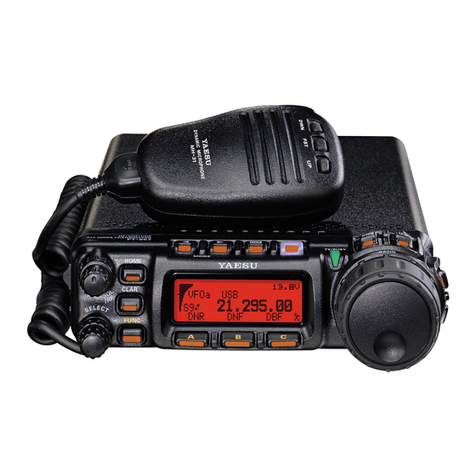
Yaesu
Yaesu FT-857D User manual

Yaesu
Yaesu FT-200 User manual

Yaesu
Yaesu FT-767GX User manual
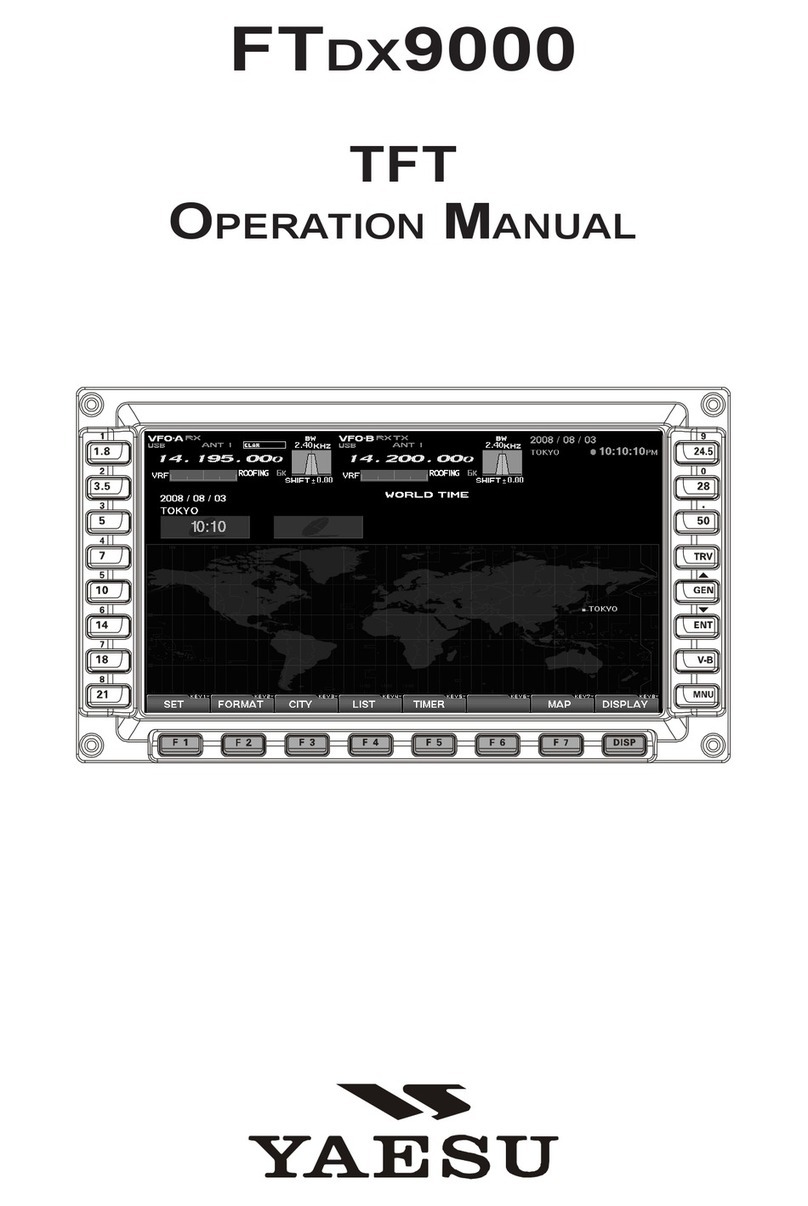
Yaesu
Yaesu FT DX 9000 TFT User manual
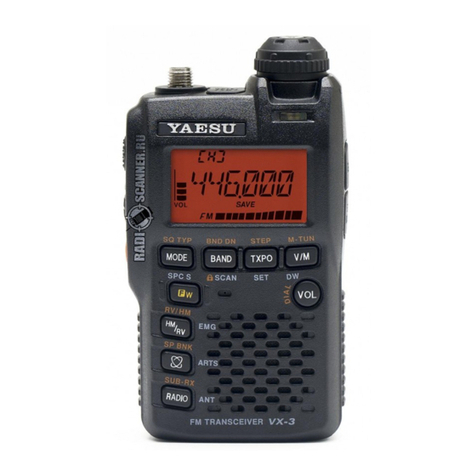
Yaesu
Yaesu VX-3R User manual

Yaesu
Yaesu FT-75B User manual
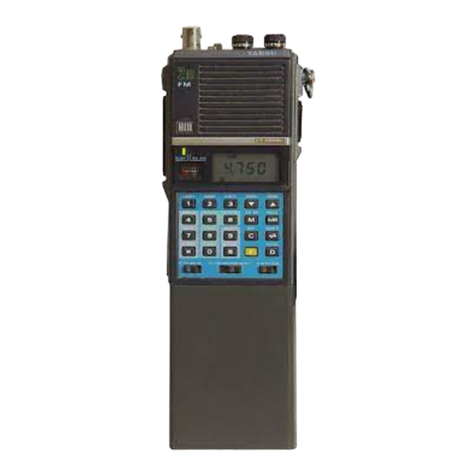
Yaesu
Yaesu FT-209R User manual
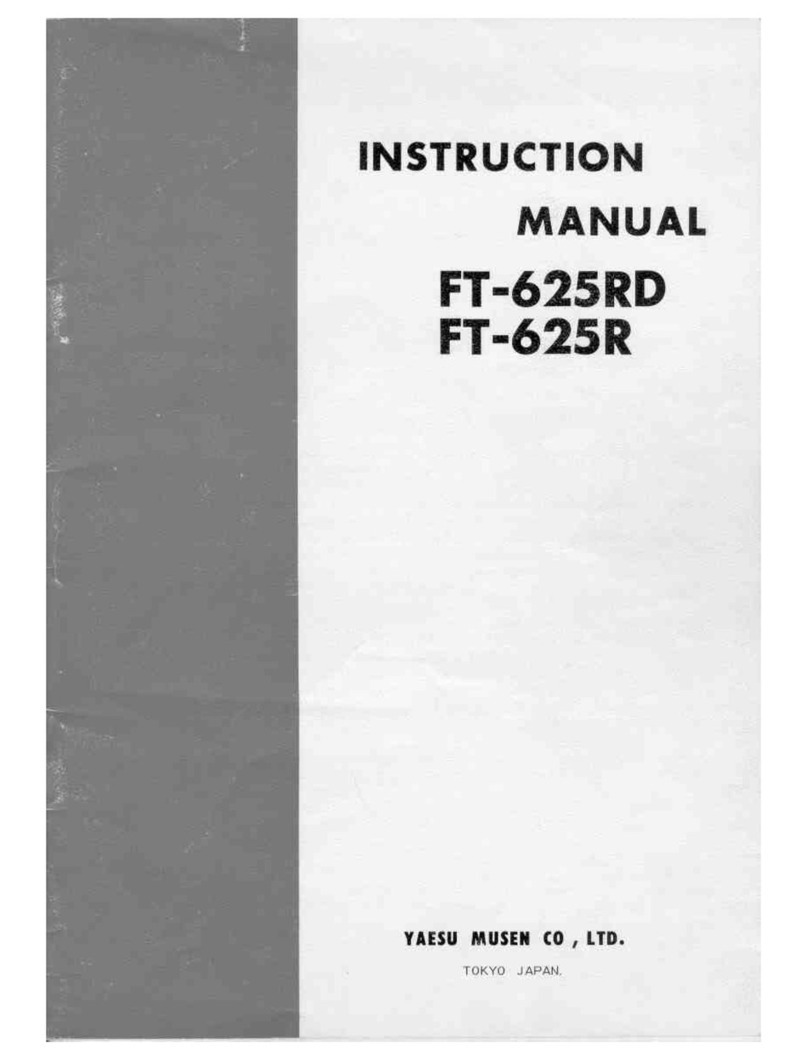
Yaesu
Yaesu FT-625RD User manual

Yaesu
Yaesu FT3DR User manual

Yaesu
Yaesu VX-8GE User manual


